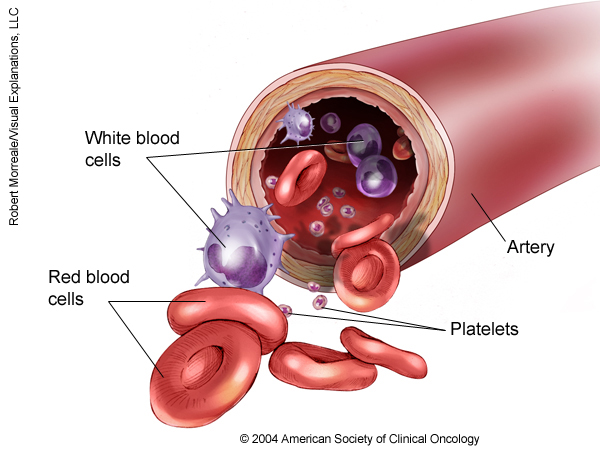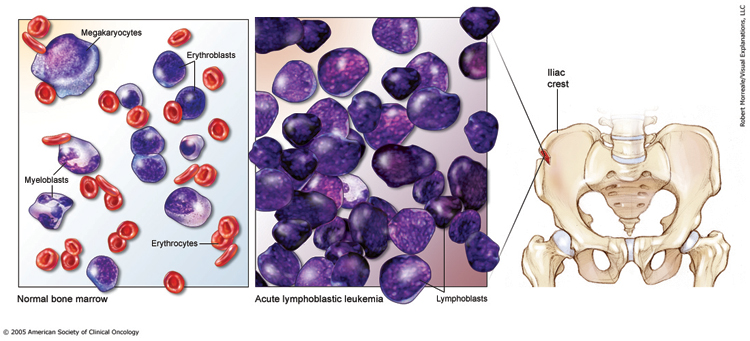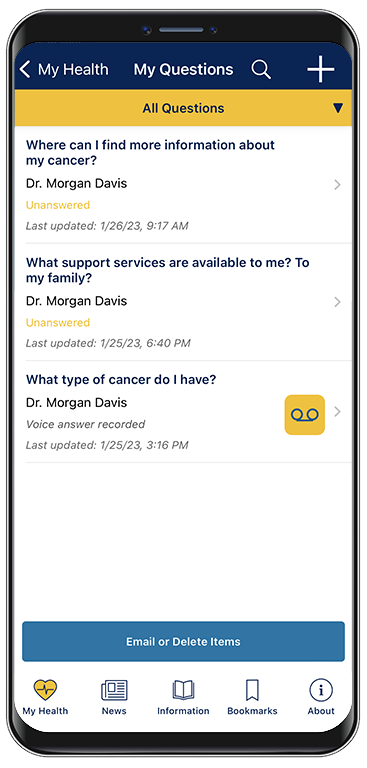ON THIS PAGE: You will learn about the different types of treatments doctors use for children with acute lymphoblastic leukemia (ALL). Use the menu to see other pages.
In general, cancer in children is uncommon. This means it can be hard for doctors to plan treatments unless they know what has been most effective in other children. That is why more than 60% of children with cancer are treated as part of a clinical trial. A clinical trial is a research study that tests a new approach to treatment. The “standard of care” is the best treatments known based on previous clinical trials. Clinical trials may test such approaches as a new drug, a new combination of existing treatments, or new doses of current therapies. The health and safety of all children participating in clinical trials are closely monitored.
To take advantage of these newer treatments, children with cancer should be treated at a pediatric cancer center or a cancer center with access to specialists in pediatric cancer. Doctors at these centers have extensive experience in treating children with cancer and have access to the latest research. A doctor who specializes in treating children with cancer is called a pediatric oncologist.
How childhood ALL is treated
In many cases, a team of doctors works with a child and the family to provide care. This is called a multidisciplinary team. Pediatric cancer centers often have extra support services for children and their families, such as child life specialists, nutritionists, physical and occupational therapists, social workers, and counselors. Special activities and programs to help your child and family cope may also be available.
Treatment options and recommendations depend on several factors, including the classification of ALL, possible side effects, and the patient’s preferences and overall health. Take time to learn about all of your child’s treatment options and be sure to ask questions about things that are unclear. Talk with your child’s doctor about the goals of each treatment and what your child can expect while receiving the treatment. These types of talks are called “shared decision-making.” Shared decision-making is when you and the doctors work together to choose treatments that fit the goals of your child’s care. Shared decision-making is particularly important for childhood ALL because there are different treatment options. Learn more about making treatment decisions.
Descriptions of common types of treatments used for childhood ALL are listed below. Your child's care plan also includes treatment for symptoms and side effects, an important part of cancer care.
The 3 types of treatments used to treat childhood ALL are chemotherapy, radiation therapy, and stem cell transplantation/bone marrow transplantation. All children with ALL receive chemotherapy. Some children will also need radiation therapy or stem cell transplantation/bone marrow transplantation.
Chemotherapy
Chemotherapy is the use of drugs to destroy cancer cells, usually by keeping the cancer cells from growing, dividing, and making more cells.
A chemotherapy regimen, or schedule, usually consists of a specific number of cycles of drugs given over a set period of time. A patient may receive 1 drug at a time or combinations of different drugs given at the same time.
Chemotherapy is the primary treatment for ALL. It may be given by mouth (orally), injected into a vein or muscle, or injected into the cerebral spinal fluid (CSF). It is generally done in four phases:
-
Remission induction therapy uses chemotherapy to destroy as many of the leukemia cells as possible to cause the cancer to go into remission.
-
Central nervous system directed therapy destroys any leukemia cells in the central nervous system and prevents the spread of the disease to the spinal fluid.
-
Consolidation therapy begins when the child’s leukemia has gone into remission. Higher doses of chemotherapy, or drugs not used during previous treatment, are used to destroy most of the remaining leukemia cells.
-
Continuation or maintenance therapy lasts for two to three years to destroy any remaining (residual) leukemia cells.
The side effects of chemotherapy depend on the individual and the dose used, but they can include short-term side effects like hair loss, fatigue, loss of appetite, nausea and vomiting, diarrhea, and kidney and liver problems. If a drug called vincristine (Oncovin, Vincasar) is part of your child’s chemotherapy, there may be muscle weakness and nerve pain. These side effects usually go away after treatment is finished. Other side effects related to chemotherapy that may last longer or develop after treatment is finished include bone and joint problems and learning problems.
The severity of the side effects depends on the type and amount of the drug being given and the length of time the child receives the drug. The side effects each child experiences may also be affected by other factors, including biological differences in the way the medications are processed by the body, the child or teen’s age when diagnosed, and their overall health. That's why it is important to let your child's cancer care team know if your child is experiencing any changes in how they are feeling. Talk with your child's doctor regularly about what side effects are likely and how they can be managed.
Learn more about the basics of chemotherapy.
Return to top
Radiation therapy
Radiation therapy is the use of high-energy x-rays or other particles to destroy cancer cells. A doctor who specializes in giving radiation therapy to treat cancer is called a radiation oncologist. The most common type of radiation treatment is called external-beam radiation therapy, which is radiation given from a machine outside the body. A radiation therapy regimen, or schedule, usually consists of a specific number of treatments given over a set period of time.
Radiation therapy for ALL is has recently been used when the leukemia has spread to the brain, spinal fluid, or the testicles, or in high-risk disease to help prevent the spread of leukemia to the spinal fluid. However, with current treatment regimens, radiation therapy is typically reserved for recurrent or refractory disease, and in some centers, patients with T-cell leukemia.
Side effects from radiation therapy may include hair loss, fatigue, mild skin reactions, upset stomach, and loose bowel movements. Talk with your child's doctor about what side effects may happen and how they can be managed. Most side effects go away soon after treatment is finished. However, long-term side effects of radiation treatment to the brain and body can occur and may possibly include hormone problems affecting growth and metabolism, learning problems, and an increased risk of developing a second cancer including a brain tumor, skin cancer, salivary gland cancer, and thyroid cancer can also occur after radiation treatment for ALL (see Follow-up Care).
Learn more about the basics of radiation therapy.
Return to top
Bone marrow transplantation/stem cell transplantation
Bone marrow/stem cell transplantation is most often used as a treatment for recurrent or refractory ALL. Rarely, transplantation may be recommended as part of the initial therapy when leukemia is associated with very high-risk features.
A bone marrow transplant is a medical procedure in which bone marrow that contains cancer is replaced by highly specialized cells. These cells, called hematopoietic stem cells, develop into healthy bone marrow. Hematopoietic stem cells are blood-forming cells found both in the bloodstream and in the bone marrow. This procedure is also called a stem cell transplant or hematopoietic stem cell transplant.
Before recommending transplantation, doctors will talk with the patient about the risks of this treatment. They will also consider several other factors, such as the type of cancer, results of any previous treatment, and the patient’s age and general health.
There are 2 types of hematopoietic stem cell transplantation depending on the source of the replacement blood stem cells: allogeneic (ALLO) and autologous (AUTO). ALLO uses donated stem cells, while AUTO uses the patient’s own stem cells. In both types, the goal is to destroy all of the cancer cells in the marrow, blood, and other parts of the body using high doses of chemotherapy and/or radiation therapy and then allow replacement blood stem cells to create healthy bone marrow.
Side effects depend on the type of transplant, your child’s general health, and other factors. Learn more about the basics of stem cell and bone marrow transplantation.
Return to top
Physical, emotional, and social effects of cancer
Leukemia and its treatment cause physical symptoms and side effects, as well as emotional, social, and financial effects. Managing all of these effects is called palliative care or supportive care. It is an important part of your child’s care that is included along with treatments intended to slow, stop, or eliminate the cancer.
Palliative care focuses on improving how your child feels during treatment by managing symptoms and supporting patients and their families with other, non-medical needs. Any person, regardless of age or type and stage of cancer, may receive this type of care. And it often works best when it is started right after a cancer diagnosis. People who receive palliative care along with treatment for the cancer often have less severe symptoms, better quality of life, and report that they are more satisfied with treatment.
Palliative treatments vary widely and often include medication, nutritional changes, relaxation techniques, emotional and spiritual support, and other therapies. Your child may also receive palliative treatments similar to those meant to get rid of the cancer, such as chemotherapy or radiation therapy.
Before treatment begins, talk with your child’s doctor about the goals of each treatment in the recommended treatment plan. You should also talk about the possible side effects of the specific treatment plan and palliative care options. Many patients also benefit from talking with a social worker and participating in support groups. Ask your doctor about these resources, too.
During treatment, your child’s health care team may ask you to answer questions about your child’s symptoms and side effects and to describe each problem. Be sure to tell the health care team if your child are experiencing a problem. This helps the health care team treat any symptoms and side effects as quickly as possible. It can also help prevent more serious problems in the future.
Learn more about the importance of tracking side effects in another part of this guide. Learn more about palliative care in a separate section of this website.
Return to top
Remission and the chance of recurrence
A remission is when leukemia cannot be detected in the body and there are no symptoms. This may also be called having “no evidence of disease” or NED.
A remission may be temporary or permanent. This uncertainty causes many people to worry that the leukemia will come back. While many remissions are permanent, it is important to talk with your child’s doctor about the possibility of the disease returning. Understanding your risk of recurrence and the treatment options may help you feel more prepared if the leukemia does return. Learn more about coping with the fear of recurrence.
If the cancer returns after the original treatment, it is called recurrent ALL. If a recurrence happens, a new cycle of testing will begin again to learn as much as possible about it. After this testing is done, you and your child’s doctor will talk about treatment options. Often the treatment plan will include the treatments described above such as chemotherapy, radiation therapy, and/or stem cell transplantation but they may be used in a different combination or given at a different pace. Treatment of recurrent ALL depends on many factors, including the type of treatment the child received originally, the length of time between the initial diagnosis and the recurrence, and whether leukemia cells are found in the bone marrow, CSF, testicles, or in more than 1 of these sites when it recurs. Your child’s doctor may suggest clinical trials that are studying new ways to treat recurrent ALL. Just as for newly diagnosed patients, clinical trials typically offer the best chance of cure. Whichever treatment plan you choose, palliative care will be important for relieving symptoms and side effects.
When ALL recurs, patients and their families often experience emotions such as disbelief or fear. Families are encouraged to talk with their health care team about these feelings and ask about support services to help them cope. Learn more about dealing with cancer recurrence.
Return to top
If treatment does not work
Although treatment is successful for many children with ALL, sometimes it is not. If a child’s leukemia cannot be cured or controlled, this is called advanced or terminal leukemia. This diagnosis is stressful, and advanced cancer may be difficult to discuss. However, it is important to have open and honest conversations with your child’s doctor and health care team to express your family’s feelings, preferences, and concerns. The health care team has special skills, experience, and knowledge to support patients and their families, and is there to help.
Hospice care is designed to provide the best possible quality of life for people who are expected to live less than 6 months. Parents and guardians are encouraged to talk with the health care team about hospice options, which include hospice care at home, a special hospice center, or other health care locations. Nursing care and special equipment can make staying at home a workable option for many families. Some children may be happier if they can attend school part-time or keep up other activities and social connections. The child’s health care team can help parents or guardians decide on an appropriate level of activity. Making sure a child is physically comfortable and free from pain is extremely important as part of end-of-life care. Learn more about caring for a terminally ill child and advanced cancer care planning.
The death of a child is an enormous tragedy, and families may need support to help them cope with the loss. Pediatric cancer centers often have professional staff and support groups to help with the process of grieving. Learn more on grieving the loss of a child.
Return to top
The next section in this guide is About Clinical Trials. It offers more information about research studies that are focused on finding better ways to care for children with cancer. Use the menu to choose a different section to read in this guide.



